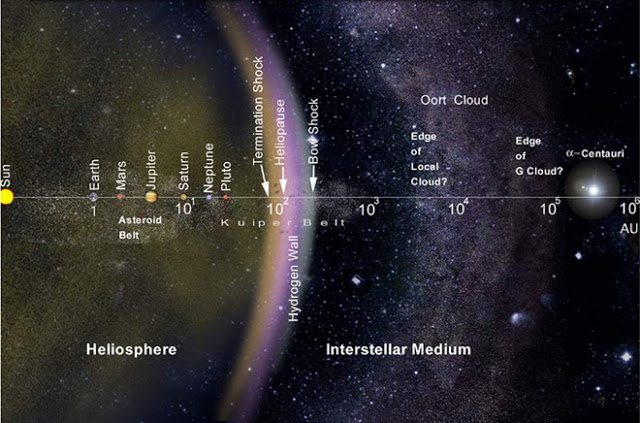There may be up to 100,000 compact objects per main sequence star in the galaxy that are greater than the mass of Pluto. The mass function of the lowest-mass nomads is modeled from what we see in the Kuiper Belt and the distribution of diameters in KBOs (Kuiper Belt Objects), while at the higher end (corresponding to masses several times that of Jupiter), evidence exists that nomads in open clusters follow a smooth continuation of the brown dwarf mass function. The larger Earth and larger size objects would also likely have their own moons.
If there were one million planet sized compact objects in a 100,000 AU on a side cube, and they were evenly distributed then each would occupy its own 1000 AU (about 30 times the distance from the Sun to Pluto) on a side cube. 100,000 objects evenly distributed would be in cubes with about 2200 AU on a side. 253000 AU is equal to 4 light years. 2200 AU is about 2 light weeks
The Oort cloud is thought to occupy a vast space from somewhere between 2,000 and 5,000 AU (0.03 and 0.08 ly) to as far as 50,000 AU (0.79 ly) from the Sun. Some estimates place the outer edge at between 100,000 and 200,000 AU (1.58 and 3.16 ly). The region can be subdivided into a spherical outer Oort cloud of 20,000–50,000 AU (0.32–0.79 ly), and a doughnut-shaped inner Oort cloud of 2,000–20,000 AU (0.03–0.32 ly). The outer cloud is only weakly bound to the Sun and supplies the long-period (and possibly Halley-type) comets to inside the orbit of Neptune. Models predict that the inner cloud should have tens or hundreds of times as many cometary nuclei as the outer halo.
The outer Oort cloud is believed to contain several trillion individual objects larger than approximately 1 km (0.62 mi) (with many billions with absolute magnitudes brighter than 11—corresponding to approximately 20 km (12 mi) diameter), with neighboring objects typically tens of millions of kilometres apart. Its total mass is not known with certainty, but, assuming that Halley’s comet is a suitable prototype for all comets within the outer Oort cloud, the estimated combined mass is 3×10^25 kg (7×10^25 lb or roughly five times the mass of the Earth). Earlier it was thought to be more massive (up to 380 Earth masses), but improved knowledge of the size distribution of long-period comets has led to much lower estimates.
The new theory is that there a lot more bigger wandering planets.
Arxiv – Nomads of the Galaxy (10 pages) (H/T Centauri Dreams)
We estimate that there may be up to 100,000 compact objects in the mass range 10^−8 − 10^−2 M per main sequence star that are unbound to a host star in the Galaxy. We refer to these objects as nomads; in the literature a subset of these are sometimes called free-floating or rogue planets. Our estimate for the number of Galactic nomads is consistent with a smooth extrapolation of the mass function of unbound objects above the Jupiter-mass scale, the stellar mass density limit, and the metallicity of the interstellar medium. We analyze the prospects for detecting nomads via Galactic microlensing. The Wide-Field Infrared Survey Telescope (WFIRST) will measure the number of nomads per main sequence star greater than the mass of Jupiter to ∼ 13%, and the corresponding number greater than the mass of Mars to ∼ 25%. All-sky surveys such as Gaia and LSST can identify nomads greater than about the mass of Jupiter. We suggest a dedicated drift scanning telescope that covers approximately 100 square degrees in the Southern hemisphere could identify nomads as small as 10−8M via microlensing of bright stars with characteristic lightcurve timescales of a few seconds.
A dedicated high cadence survey of the inner Galaxy, such as would be possible with Wide-Field Infrared Survey Telescope (WFIRST), could measure the number of nomads greater than the mass of Jupiter per main sequence star to ∼ 13% , and the corresponding number greater than the mass of Mars to ∼ 25%. Also WFIRST can measure the minimum mass of the nomad population to about 30%. Large-scale surveys, in particular that of Gaia, could identify nomads in the Galactic disk that are greater than about the mass of Jupiter.
If you liked this article, please give it a quick review on ycombinator or StumbleUpon. Thanks

Brian Wang is a Futurist Thought Leader and a popular Science blogger with 1 million readers per month. His blog Nextbigfuture.com is ranked #1 Science News Blog. It covers many disruptive technology and trends including Space, Robotics, Artificial Intelligence, Medicine, Anti-aging Biotechnology, and Nanotechnology.
Known for identifying cutting edge technologies, he is currently a Co-Founder of a startup and fundraiser for high potential early-stage companies. He is the Head of Research for Allocations for deep technology investments and an Angel Investor at Space Angels.
A frequent speaker at corporations, he has been a TEDx speaker, a Singularity University speaker and guest at numerous interviews for radio and podcasts. He is open to public speaking and advising engagements.




